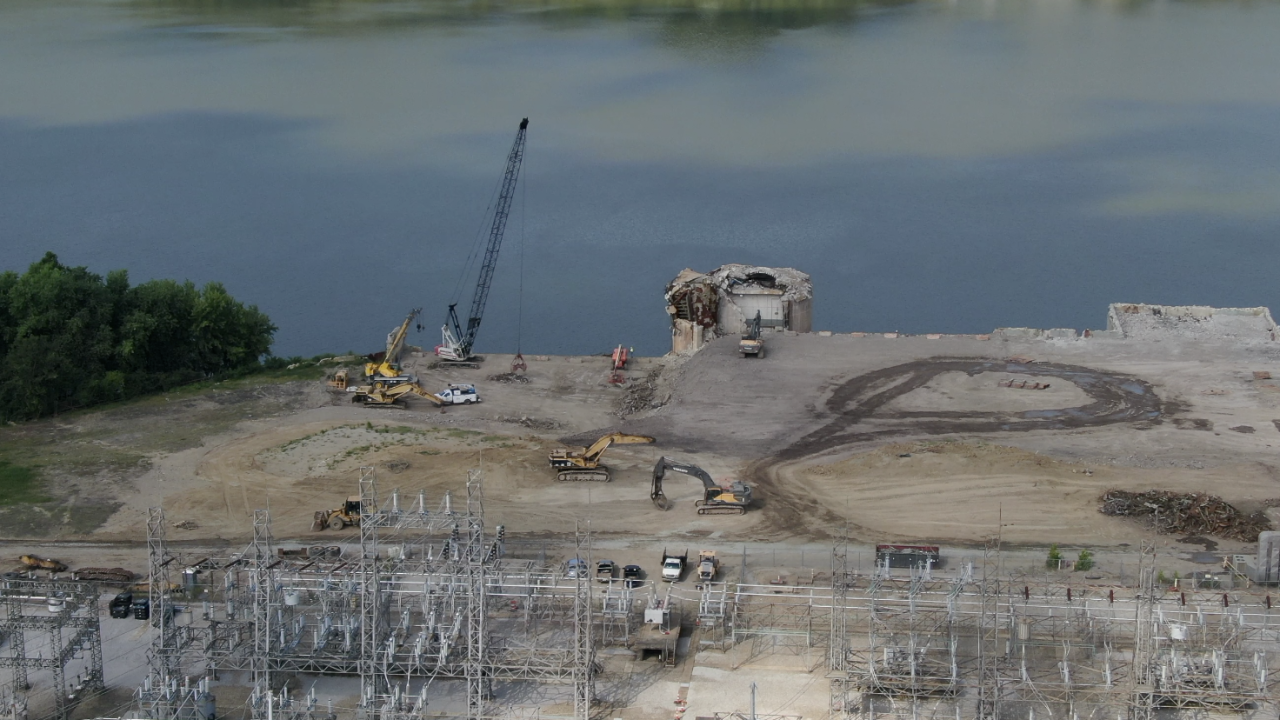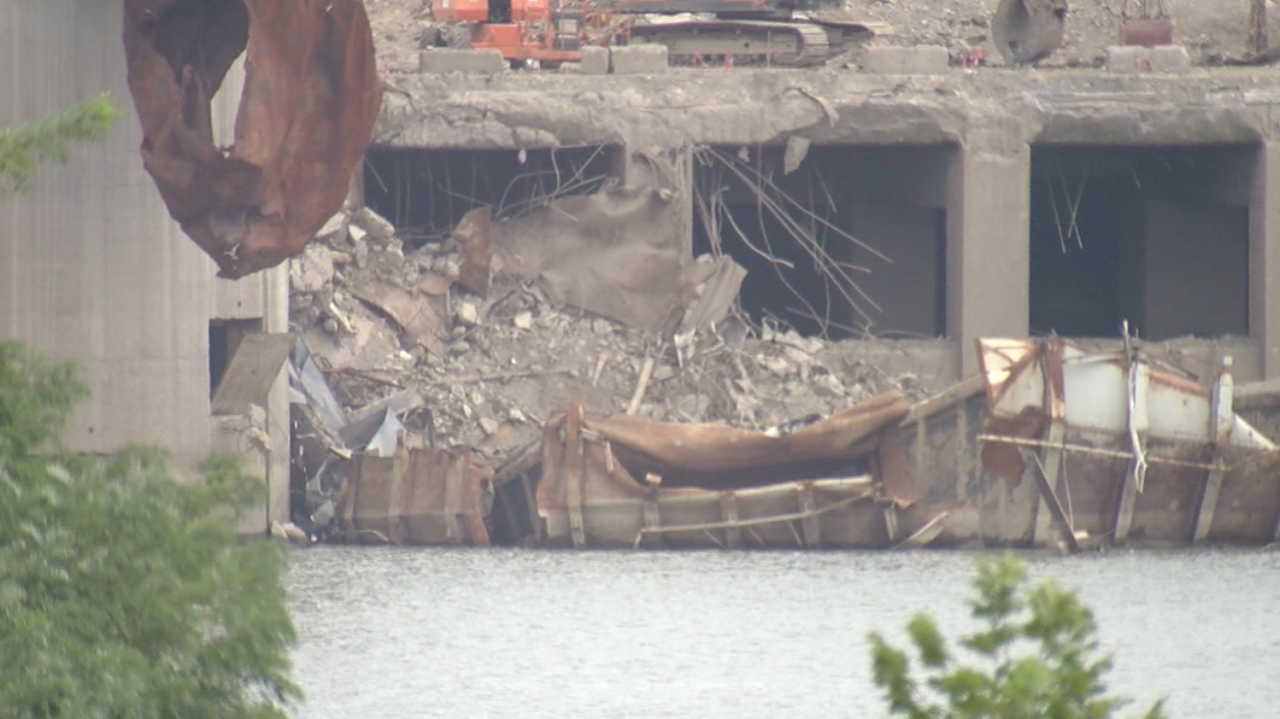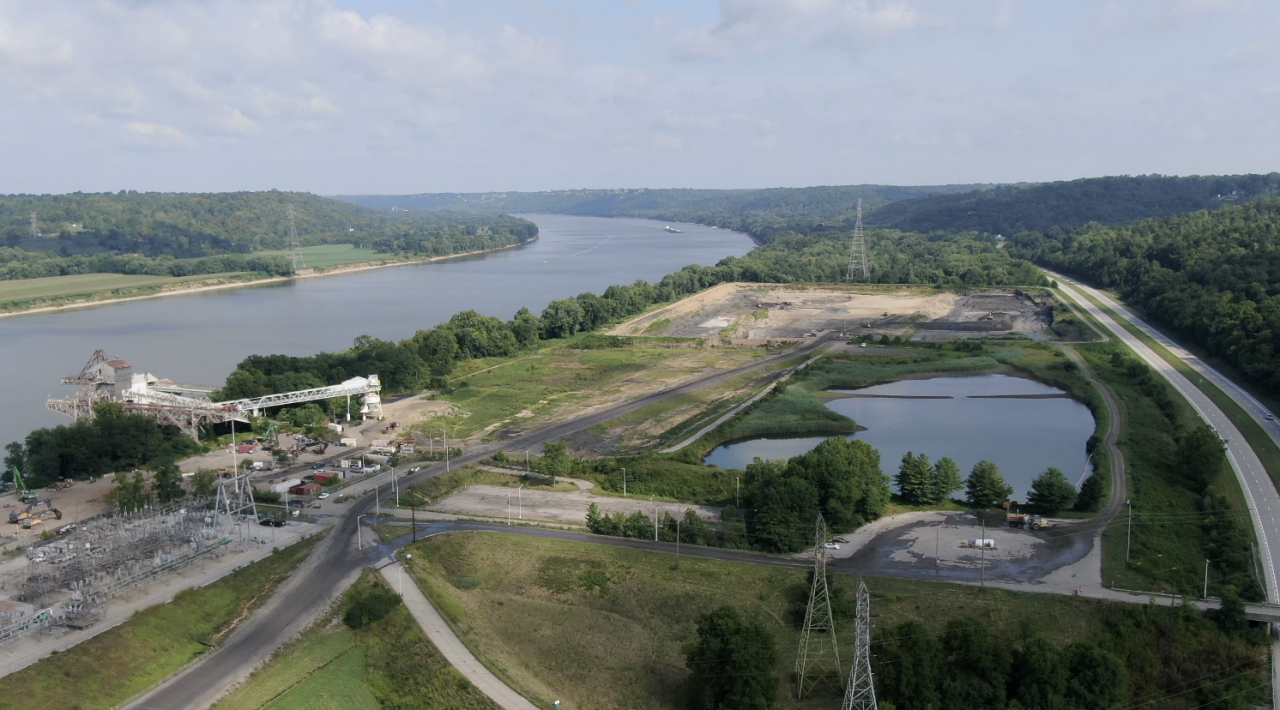NEW RICHMOND, Ohio — Clermont County residents expected a barge-mounted crane to arrive in August and finally remove a smokestack that toppled into the Ohio River during demolition of the retired Walter C. Beckjord coal plant in February.
But divers made a surprising discovery underwater last week: an intact metal liner from the smokestack that is at least 100 feet long – the length of six cars.
The crane that contractors had planned to use is not big enough to remove the liner. It will be at least October until a larger piece of equipment is available, according to the U.S. Army Corps of Engineers, which oversees the cleanup.
This latest delay adds to the frustration that New Richmond residents and local officials have been vocal about for months.

More than five million people rely on the Ohio River as a source of drinking water. It also serves as the recreational play area for thousands of boaters, tubing children and jet skiers during the summer.
Even if the new crane arrives on time in October,it will be nine months since the smokestack debris has been underwater and a year since debris from an earlier boiler demolition at Beckjord has been in the Ohio River.
“I’m still concerned it’s in the river and what potential impact it could have, since we really don’t know what’s in it, or what was in it,” said Pierce Township Fire Chief Craig Wright.
As the nation transitions away from coal, the colossal plants that burn it are being shuttered up and down the Ohio River. Ohio has more coal plant closures and retirement announcements than any other state in the nation.
This leaves questions in the communities that once hosted them. Perhaps the biggest: How will the sites be cleaned up? And who is monitoring them?
Some say the delayed cleanup of demolition waste in the Ohio River highlights a bigger problem about lack of oversight at the now-dormant Beckjord plant.
Built in the 1950s as a coal-burning giant, the Beckjord plant pumped electricity to hundreds of thousands of homes and businesses across Southwest Ohio for decades.

The W.C. Beckjord Station, a closed Duke Energy power plant located 20 miles east of Cincinnati, contains more than 10 billion pounds of toxins that are packed into ponds along the banks of the Ohio River.
In 2014, Duke Energy closed the Beckjord plant, where more than 5 million tons of coal ash are buried in unlined, man-made ponds along the Ohio River. It is known as a legacy site because federal rules overseeing coal combustion residuals that took effect in 2015 do not apply here.
Duke sold the 1,443-acre site in 2018 to Commercial Liability Partners, a Missouri company that had initial plans to build an industrial park, green space and port terminal.
After the sale, the complaints were almost immediate.

Neighbors sued the limited liability that CLP formed to manage the plant’s remediation in late 2019. Residents complained to the Ohio EPA last summer about massive dust clouds rising from coal ash ponds.
An environmental consultant for Clermont County questioned last summer whether the company’s groundwater monitoring plan is adequate.
Now CLP faces the threat of a second lawsuit. In May, more than 100 Pierce Township residents sent notice of an intent to sue CLP if it did not stop alleged open dumping of coal ash.
Meanwhile the Army Corps has been trying to force CLP and its contractors to clean up debris in the Ohio River since Clermont County and township officials first complained in January.
But cleanup efforts have been hampered by delays and inconsistent information.
Hours after the February 26 demolition of Beckjord’s tallest smokestack at more than 400 feet, Aaron Fitch, a vice president for the demolition contractor, MCM Management Corp., sent an email to regulators admitting that some of it had fallen into the Ohio River.
“Approximately 30 to 40 feet of the stack did fall riverside.”
Now divers have confirmed what critics have been saying for months: there is actually much more Beckjord waste in the Ohio River than initially reported to regulators.

What’s inside of that smokestack has been a constant question from residents.
“I do have huge concerns,” Wright told WCPO in April. “It’s not just Clermont County’s drinking water, it’s the city of Cincinnati’s and Hamilton County’s and Northern Kentucky’s. It’s much larger than just us.”
Ohio regulations require that asbestos be removed from structures before demolition, and that did happen at Beckjord, according to an October 2019 application letter by MCM to the Corps.
But non-asbestos materials are not regulated, according to an Ohio EPA spokesperson.

So it is unlikely that public records exist that reveal whether the Beckjord smokestack contained coal ash or other pollutants, or if it was cleaned before it imploded and fell into the river, because contractors do not need to provide that documentation to regulators.
“The Beckjord power plant has been decommissioned, coal ash removed and asbestos abated,” Fitch wrote in a permit application to the Corps signed in February 2020, which did not contain test results.
Based on documentation it received from the contractor, a Corps of Engineers spokesman said in March that any debris in the Ohio River is simply "brick and mortar."
The Corps of Engineers sent an April 15 compliance letter to MCM ordering the company to submit a clean-up plan by the end of April. At that point, MCM estimated there was 75 cubic yards of demolition debris in the river, or enough to fill 2.5 commercial construction dumpsters.

A series of delays followed, because the Army Corps requested changes to proposed cleanup plans, and MCM asked for more time due to safety concerns, and their inability to secure a marine contractor or the right equipment.
A barge-mounted crane was set to arrive on August 2, but was delayed until August 9. In the meantime, divers hired by the contractors surveyed the river last week and discovered the metal liner.
In a statement to WCPO, a spokesman for CLP wrote: “MCM and their subcontractor, C.J. Mahan, are working under an approved permit and the direction of the U.S. Army Corps of Engineers on the removal of the remaining debris. Divers were brought in last week to assess what remains and to determine the proper equipment needed for final removal. We will provide an update once the process is complete.”

An Army Corps spokesperson said no fines or penalties have been levied against CLP or its contractors; “however, that does not preclude the Corps from seeking penalties in the future.”
Meanwhile efforts are being undertaken to find other available equipment. But most are already under contract, according to the Army Corps.
“There has been equipment in Arkansas identified, which could arrive onsite by October 1. In the interim, USACE has requested that the permittee make every effort to scour the inland waterways to find available equipment that could be onsite sooner, if at all possible,” said Corps spokesperson Katie Newton.

When asked why contractors only just realized the true amount of debris in the river, Newton said: “The initial debris estimate provided was based on rudimentary SONAR. Divers have since been able to provide more precise information. The divers didn’t investigate immediately due to unfavorable river conditions.”
Meanwhile, most of the boiler debris, including twisted metal and construction waste, has been cleaned from the Beckjord riverfront. That cleanup should be finished by the end of the week.
But the boiler debris in the Ohio River remains, nearly 10 months after it fell underwater.
“The debris is not impacting the navigation channel. There have not been any complaints from the navigation industry,” Newton said.





